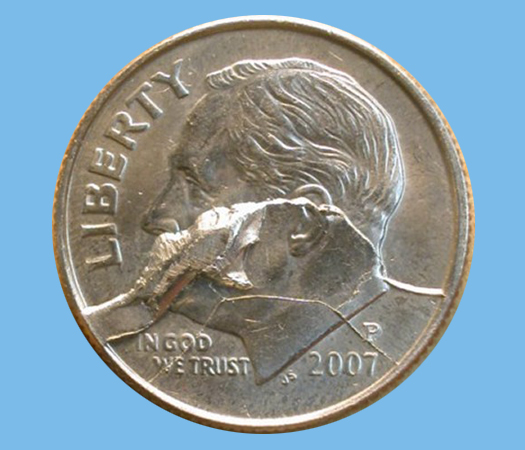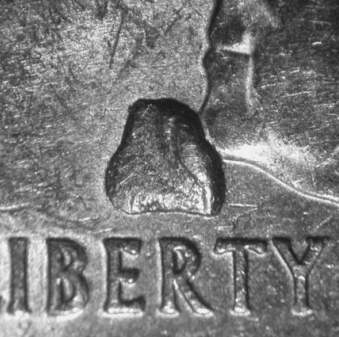Interior Die Breaks
Connected to a Die Crack or Split
Definition: When a thick flake spalls off the interior of the die face it leaves a void, we call an interior die break. It appears on the coin as a featureless lump. Unlike a cud, an interior die break has no direct connection to the design rim. Interior die breaks are often connected to die cracks and sometimes straddle a split in the die face (split die). When it is not connected to a die crack, it is called a freestanding interior die break. To be an Interior Die Break, the break must be larger than 4 square millimeters.
This 2007-D dime shown below was struck by a shattered obverse die. Many forms of brittle fracture are evident, including a 50% retained cud and many bi-level die cracks. A large interior die break has replaced Roosevelt’s mouth and cheek.

Free Standing
Definition: It’s a rare event when a die chip is so large that it warrants being designated an interior die break. Interior die breaks should not be confused with “cuds”. By definition, a cud is a die break that includes the rim and at least a little bit of the field.
Interior die breaks have no direct connection to the rim. They may have an indirect connection via a die crack or split die.
Since voids left in the die face by natural fractures span an unbroken size continuum, there is no clear boundary between a “die chip” and an “interior die break”.
Any void encompassing an area of 4 square millimeters or more qualifies as an interior die break. Any void that covers less than 1 square millimeter is a die chip. In between is a gray area. Die chips are commonly encountered in all denominations. In Lincoln cents they include “BIE” errors, “plugged” 5’s and 9’s, and “bugs in the wheat ear”.
Maryland quarter with a large, freestanding interior die break at the tip of Washington’s chin.
